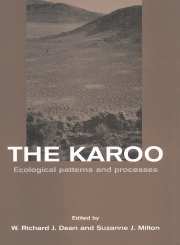Book contents
- Frontmatter
- Contents
- List of contributors
- Foreword
- Preface
- Acknowledgements
- Part one Biogeographic patterns and the driving variables
- Part two Form and function
- Part three Dynamics
- Part four Human impacts
- Part five Comparisons
- 18 Comparison of ecosystem processes in the Nama-karoo and other deserts
- 19 The succulent karoo in a global context: plant structural and functional comparison with North American winter-rainfall deserts
- 20 The karoo: past and future
- References
- Index
20 - The karoo: past and future
Published online by Cambridge University Press: 23 December 2009
- Frontmatter
- Contents
- List of contributors
- Foreword
- Preface
- Acknowledgements
- Part one Biogeographic patterns and the driving variables
- Part two Form and function
- Part three Dynamics
- Part four Human impacts
- Part five Comparisons
- 18 Comparison of ecosystem processes in the Nama-karoo and other deserts
- 19 The succulent karoo in a global context: plant structural and functional comparison with North American winter-rainfall deserts
- 20 The karoo: past and future
- References
- Index
Summary
Current perceptions
Patterns
The succulent karoo is unique, with high levels of endemism and species-richness in succulent and geophytic plants. It is also extraordinarily species-rich in certain groups of invertebrates and reptiles, although not in mammals and birds (Vernon, this volume). Speciesrichness in succulent karoo Mesembryanthema is currently attributed to the dependable winter rainfall in a hot arid climate (Cowling and Hilton-Taylor, this volume; Esler et al., this volume). The Nama-karoo, on the other hand, may be seen as a vast ecotonal area in which the affiliation of the fauna and flora with a particular biome appears to be determined as much by local edaphic factors as it does by geographical position. Within the Namakaroo, the structural heterogeneity of the vegetation is correlated with climatic variability (Cowling et al., 1994).
Rainfall seasonality appears to have been a powerful force in the evolution of karoo plants. Dependable, but light, winter rainfall in combination with hot arid summers have favoured CAM photosynthesis, leaf-stored water and shallow roots – doubtless accounting for the dominance of leaf-succulent Mesembryanthema in the succulent karoo (Esler et al., this volume). Highly variable and non-seasonal rainfall in the Nama-karoo enables a greater variety of structural forms to coexist in this comparatively poor vegetation. The relative abundance of deep- and shallow-rooted plants, ephemerals and perennials, succulent shrubs and grasses is spatially and temporally variable, being mediated by edaphic factors and the distribution of moisture in the landscape.
- Type
- Chapter
- Information
- The KarooEcological Patterns and Processes, pp. 314 - 318Publisher: Cambridge University PressPrint publication year: 1999
- 2
- Cited by



